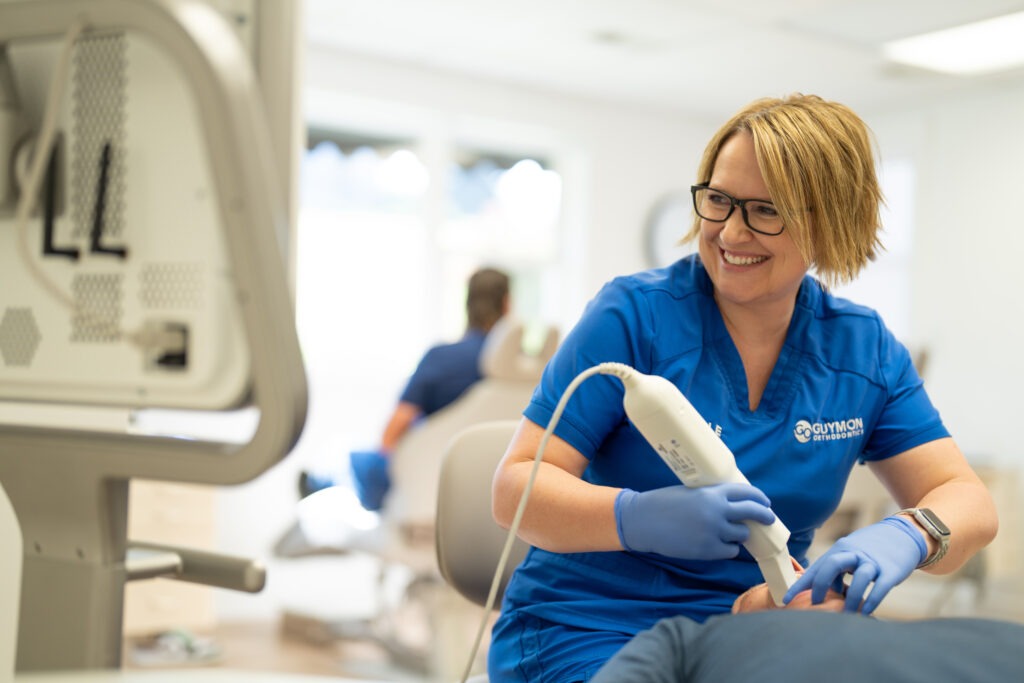At Guymon Orthodontics, we understand that a beautiful smile can make a world of difference. That’s why Dr. Guymon and our dedicated team are committed to providing the best orthodontic care with a personal touch. Braces, a key tool in our orthodontic arsenal, consist of several intricate parts, each playing a crucial role in shaping your perfect smile. Let’s explore the components of braces, starting with the foundation – brackets.
Brackets – The Cornerstone of Braces
Brackets may seem like small components of braces, but they play a pivotal role in the journey to a perfect smile:
- Function and Types: Brackets are directly bonded to each tooth, serving as the anchor points for the braces. Dr. Guymon utilizes different types of brackets, including traditional metal, ceramic, and even lingual brackets, depending on the specific needs and preferences of each patient.
- Role in Treatment: Each bracket is meticulously placed at a precise angle and position on the tooth. This careful placement is crucial for directing the movement of each tooth. Brackets work in tandem with the archwire to apply consistent pressure, guiding teeth to their correct positions.
- Customization and Aesthetics: For those concerned about the appearance of metal braces, Dr. Guymon offers ceramic brackets, which are less noticeable. He also provides options for customization, like colored bands, allowing patients to personalize their braces experience.
- Maintenance and Care: Dr. Guymon emphasizes the importance of maintaining good oral hygiene with brackets. He provides detailed guidance on cleaning around brackets to prevent plaque buildup and ensure the effectiveness of the treatment.
In the next section, we will look at archwires, the elements that work hand-in-hand with brackets to achieve the desired orthodontic results.
Archwires – The Guiding Force of Braces
Archwires are often described as the ‘guiding force’ that works in conjunction with brackets. Let’s look into the crucial role of wires in orthodontic treatment:
- Function and Varieties: The main function of archwires in braces is to apply consistent pressure to move teeth into the desired position. Dr. Guymon selects from various types of wires, including stainless steel, nickel-titanium, and copper-titanium, based on each patient’s unique orthodontic needs.
- Role in Treatment: Wires are the dynamic elements of braces, threaded through each bracket and adjusted periodically by Dr. Guymon. These adjustments are essential to ensure the wires exert the correct amount of force, facilitating effective and efficient tooth movement.
- Customization and Adaptability: Dr. Guymon tailors the choice of wire material to the specific requirements of each patient’s treatment plan. This customization ensures optimal comfort and effectiveness throughout the orthodontic journey.
- Maintenance and Care: Understanding the importance of maintaining braces, Dr. Guymon provides comprehensive advice on caring for wires. He emphasizes the need for regular check-ups to adjust the wires and ensure they remain effective in aligning teeth.
In the following section, we will explore bands and elastics, which play a vital supporting role in the braces system.
Bands and Spacers – Foundations for Your Orthodontic Journey
As integral parts of the orthodontic process, bands and spacers lay the groundwork for a successful braces treatment.
Bands – Anchoring the Braces:
- Function and Placement: Bands are strong rings, typically made of metal, fitted around the back molars. They serve as anchor points for braces. Dr. Guymon meticulously fits these bands to ensure a secure foundation for the orthodontic appliance.
- Role in Treatment: The bands are critical for attaching various components of the braces, such as wires and springs.
- Customization: These bands are selected to fit each tooth precisely.
Spacers – Creating Necessary Space:
- Function and Purpose: Spacers, or separators, are small elastic rings placed between teeth, usually the molars. They are used to create enough space for bands to be placed comfortably.
- Duration and Monitoring: Spacers are temporary, usually in place for a week or two. During this period, Dr. Guymon monitors the progress and prepares for the next step of fitting bands.
- Patient Experience: While spacers are in place, patients may feel some pressure or discomfort, which is normal.
Additional Components of Braces
Beyond the primary elements like brackets and wires, braces comprise several additional components that play a vital role in the orthodontic journey.
Elastics (Rubber Bands) – Enhancing Alignment:
- Function and Application: Elastics are small rubber bands that exert additional pressure to correct the alignment of teeth and jaw.
- Role in Treatment: These bands are often essential for correcting bite issues and are changed regularly to maintain consistent pressure.
- Patient Compliance: Dr. Guymon emphasizes the importance of following instructions for wearing these elastics to ensure the success of the treatment.
Power Chains – Closing Gaps:
- Function and Benefits: Power chains are a series of connected elastics forming a continuous band.
- Application in Treatment: These chains are particularly useful in the later stages of treatment for fine-tuning tooth position.
Forsus Appliances – Correcting Overbites:
Purpose and Mechanism: Forsus appliances are used in cases of significant overbites. These spring-loaded devices apply continuous pressure, aiding in the correction of jaw alignment.
Advantages in Treatment: They provide a constant force, which can be more effective and less reliant on patient compliance compared to elastics.
Palatal Expanders – Widening the Upper Jaw:
Function and Need: In some cases, Dr. Guymon uses palatal expanders to gradually widen the upper jaw and create space for teeth or correct a crossbite.
Process and Monitoring: This device is adjusted regularly to apply gentle pressure on the upper jaw.
These additional components are vital in addressing specific orthodontic needs and ensuring the comprehensive success of braces treatment.
Embracing the Guymon Orthodontics Experience
Dr. Guymon’s mastery of orthodontics is evident through his meticulous use of every component of braces, tailored to meet each patient’s unique needs. At Guymon Orthodontics, we believe in providing personalized, effective treatment plans that promise not just aesthetic improvements but long-term dental health. We invite you to schedule a free consultation with Dr. Guymon to start your journey towards a beautiful, confident smile.
Remember, a perfect smile is just an appointment away at Guymon Orthodontics!



